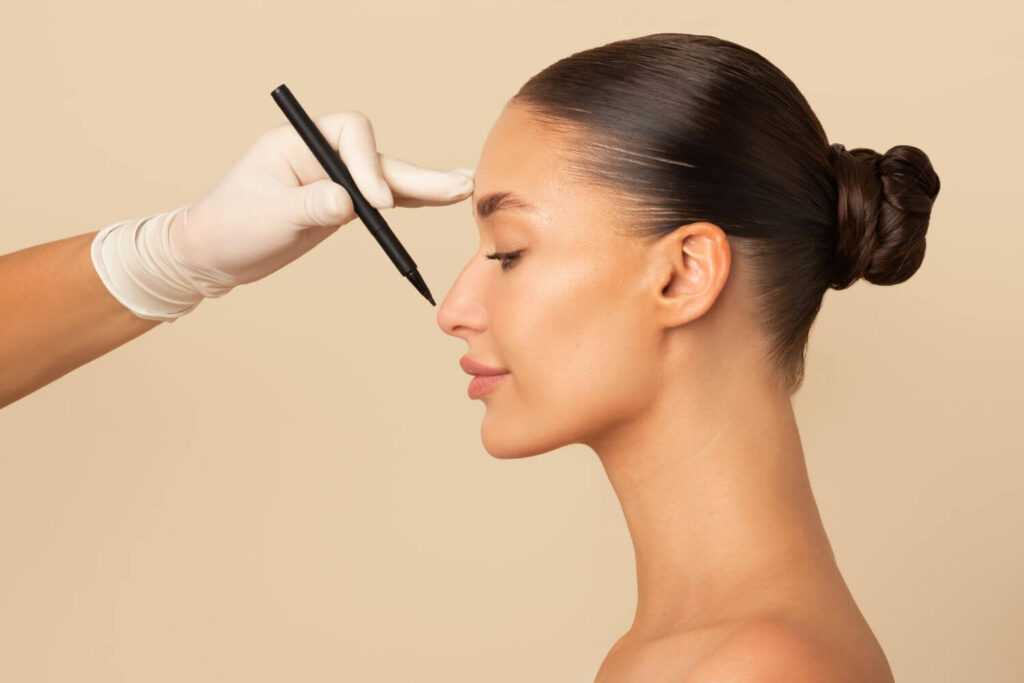Rhinoplasty, or nose surgery, is one of the most popular face procedures, and it’s easy to see why. If you’ve ever found yourself looking in the mirror and wishing your nose had a different shape, know that you’re not alone.
Many women seek out this procedure to adjust the appearance of their nose, whether it’s to correct an asymmetry, smooth out a bump, or simply to feel more confident in their own skin. But what exactly is rhinoplasty, and how does it work?
In this article, we’ll explore everything you need to know about this procedure, from what happens during the surgery to what to expect during recovery. If you’re considering rhinoplasty or just curious about the topic, keep reading to understand how this surgery can help you achieve the nose of your dreams.
And, of course, if you’re looking for rhinoplasty specialists in Miami, Smart Plastic Surgery is here to guide you through every step of this transformative process.
What is rhinoplasty?
Rhinoplasty is a plastic surgery procedure aimed at altering the shape and structure of the nose. The goal can be purely aesthetic, such as adjusting the size of the nose, redefining the tip, or even smoothing out a bump. Additionally, rhinoplasty can also be indicated to correct functional issues, like breathing difficulties caused by a deviated septum.
The procedure itself is highly personalized. During the initial consultation, the surgeon works closely with the patient to understand their specific concerns and desires. From there, a surgical plan is developed that takes into account the patient’s unique nasal anatomy and aesthetic goals.
So, whether for aesthetic or functional purposes, rhinoplasty offers an effective solution for those looking to modify their nose. If you or your patients are considering this surgery, it’s crucial to understand that each procedure is unique and should be approached with care and expertise. Choosing a qualified surgeon, like the professionals at Smart Plastic Surgery in Miami, is an important step in ensuring safe and satisfying results.
Who is a good candidate for rhinoplasty?
A good candidate for rhinoplasty is generally someone who:
- Wishes to improve the appearance of their nose for aesthetic reasons.
- Has breathing problems caused by a deviated septum or other structural abnormalities.
- Is dissatisfied with the shape, size, or proportions of their nose in relation to their face.
- Has suffered a nose injury that altered its original shape.
- Has realistic expectations regarding the results of the surgery.
- Is in good physical health, without medical conditions that could complicate the surgery or recovery.
- Is emotionally stable and capable of making informed decisions about the procedure.
- Is old enough for facial growth to be complete (usually after 16-18 years of age).
What are the different surgical approaches to rhinoplasty?
There are two main surgical approaches to rhinoplasty: open rhinoplasty and closed rhinoplasty. Each of these techniques has distinct characteristics and is chosen based on the specific needs of the patient and the complexity of the case.
Open rhinoplasty
In open rhinoplasty, the surgeon makes a small incision on the columella, which is the strip of skin separating the nostrils. This incision allows the surgeon to lift the skin and have a clear view of the internal structures of the nose, such as the cartilage and bones.
This approach is particularly useful in complex cases that require significant reshaping, as it offers greater access and precision. Although open rhinoplasty results in a small scar, it is usually almost imperceptible after healing.
Closed rhinoplasty
In closed rhinoplasty, all incisions are made inside the nostrils, meaning there are no visible external scars. This technique is often used in cases that require minor modifications or when the nasal structure allows the surgeon to achieve the goals without the need for direct visualization of the internal structures.
Recovery may be slightly quicker with the closed approach, and swelling tends to be less compared to open rhinoplasty.
Which approach is better?
The choice between open and closed rhinoplasty depends on several factors, including the complexity of the case, the patient’s preferences, and the surgeon’s recommendation. Open rhinoplasty offers greater control and precision in difficult cases, while closed rhinoplasty can be a less invasive option for simpler adjustments.
Both techniques, when performed by an experienced surgeon, can offer excellent results, whether for aesthetic or functional purposes. It’s important to discuss the available options with your surgeon and decide together which approach is most suitable for your specific case.
What is the difference between rhinoplasty and septoplasty?
Rhinoplasty and septoplasty are two surgical procedures involving the nose, but each has a specific goal and fundamental differences.
- Purpose: Rhinoplasty is primarily focused on aesthetics, while septoplasty is performed to improve respiratory function.
- Area of focus: Rhinoplasty alters the external appearance of the nose, while septoplasty corrects the internal structure.
- Indications: Rhinoplasty is indicated for those who want to modify the shape of their nose, while septoplasty is indicated for those with breathing difficulties due to a deviated septum.
- Combination: In some cases, the two procedures can be combined, especially when the patient wants to improve both the appearance and function of the nose. This combination is often referred to as septorhinoplasty.
These differences highlight the importance of discussing your specific needs with a specialized surgeon so that you can decide which procedure is most suitable for your case.
Possible risks and complications
All surgical procedures, including rhinoplasty, carry some degree of risk. Here are the possible risks and complications associated with rhinoplasty:
- Infection
- Excessive bleeding
- Adverse reactions to anesthesia
- Visible scarring
- Unsatisfactory aesthetic result
- Nasal asymmetry
- Persistent or worsened breathing difficulties
- Temporary or permanent loss of sensation in the nose
- Rupture of small blood vessels, causing redness
- Need for revision surgery
What is the rhinoplasty recovery process?
The recovery process for rhinoplasty is a crucial step in ensuring that the surgical results are satisfactory and that the patient recovers safely. Here’s what you can expect during the recovery period:
Immediately after surgery
Right after surgery, the patient typically stays in a recovery room until the effects of anesthesia wear off. It’s common to feel some discomfort, swelling, and pressure in the nose, along with mild bleeding. The nose may be immobilized with a splint or cast, which is usually kept in place for about a week.
First week
During the first week, swelling and bruising around the eyes tend to be more intense but gradually begin to subside. It’s important to keep your head elevated while sleeping to help reduce swelling.
The surgeon may recommend using cold compresses to ease discomfort. During this period, it’s essential to avoid any strenuous physical activity and protect the nose from impacts.
By the end of the first week, the splint or cast is usually removed, and the patient will be able to see the initial results, although some swelling will still be present. Any stitches, if applicable, may also be removed at this time.
First month
In the following weeks, swelling continues to decrease, though it may still be present, especially at the tip of the nose. Most patients feel well enough to return to their normal activities, including work, after about two weeks.
However, it is recommended to avoid activities that could cause trauma to the nose, such as contact sports, for at least a month.
Following months
Residual swelling can persist for several months, but it is usually noticeable only to the patient and not to others. During this time, the nose continues to refine, and internal healing progresses.
The final results of rhinoplasty are typically visible after about a year, when the swelling has completely subsided and the nose has settled into its final shape.
Care during recovery
Some important tips for a smooth recovery include:
- Follow the surgeon’s instructions: This includes taking prescribed medications, avoiding sun exposure, and attending all follow-up appointments.
- Maintain a healthy diet: A balanced diet can aid in the healing process.
- Avoid wearing glasses: If possible, avoid wearing glasses that put pressure on the nose during the first few months of recovery.
Cost of rhinoplasty
The cost of rhinoplasty can vary widely depending on several factors, including the type of surgery, the surgeon’s experience, and the location of the surgery. The average cost of rhinoplasty in the United States is $5,483, but the total price can be much higher.
Here are some average costs for different types of rhinoplasty procedures:
- Cosmetic rhinoplasty: $8,000 – $10,000
- Revision rhinoplasty: $10,000 – $12,000
- Septoplasty: $3,000 – $11,000
- Liquid rhinoplasty: $500 – $2,500 per session
The total cost of rhinoplasty may also include anesthesia costs, pre-operative consultations, post-operative appointments, and medical equipment or supplies.
Many clinics, such as Smart Plastic Surgery in Miami, offer financing options to make rhinoplasty more accessible. Companies like CareCredit, Affirm, and Cherry can help break down the payment into monthly installments, making the procedure more affordable.
Schedule your consultation today!
If you’re considering rhinoplasty and want to clear up any doubts or learn more about how this procedure can transform your appearance, don’t wait any longer.
Schedule a consultation at Smart Plastic Surgery, the best plastic surgery clinic in Miami.
Our specialists are ready to help you achieve your aesthetic goals safely and confidently.
📆 Contact us today and take the first step toward a new version of yourself!



